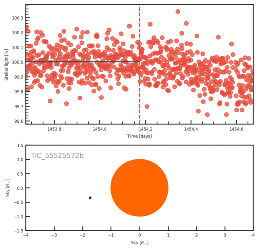PHT may well have found its first planets! They are not yet confirmed, but we have taken the big step of uploading the candidates to ExoFOP, the website used by the worldwide exoplanet community to contribute to the follow-up TESS planet candidates. If all goes well, the additional ground-based observations that are needed to confirm whether our candidates are really planets will be made soon.
It all started when a very exciting planet was brought up and discussed on Talk by Dolorous Edd, mhuten, davidbundy77, zbish and Vidar. This is the first of three candidates we uploaded so far, and is currently my favourite. TIC 55525572.01 is a long period planet candidate that appears in multiple observational sectors. The fact that the dips don’t repeat in any one sector is likely to be the reason why the official TESS pipeline didn’t find it (yet!). The widely separated transits suggest that the planet candidate completes an orbit every 83.4 days, making this the longest period planet found in the TESS data so far (as far as we know)!
From Talk to Telescope

Phase folded lightcurve.
It was exactly three weeks ago today when I first saw the lightcurve of TIC 55525572, a subgiant star which is potentially hosting a beautiful, distant world. Prepped with strong coffee, awesome data and many pages of code we spent the afternoon pulling together figures, parameters, models and plots in order to find out everything we could about the transit events. If this candidate was going to pass the scrutiny of the planet-jury we would need a whole file of evidence. The initial checks included looking at the plots of the background flux and stability of TESS at the time of the transits; checking whether the lightcurve extraction aperture size had an effect on the size and shape of the dips; and making sure that the brightest points in the aperture didn’t move during the transit. All these tests were passed with flying colours, which urged us to move on to modelling the transit event, to see what kind of a planet it would be, if it really is a planet. Amongst other things the models showed that all three of the observed transits have the same depth and width; and revealed that, if the planet is real, it has a radius that is approximately 7 times greater than that of the Earth. At this point we were happy to call it bona fide planet candidate and upload it to ExoFOP as a “community TESS Object of Interest”, or cTOI. The candidate is now known as cTOI 55525572.01.

Model of cTOI 55525572.01.
Next, we wanted to gain a better understanding of the entire system, and thus we needed to obtain a spectrum of the host star in order to accurately determine properties such as its mass, radius and temperature. Due to the very Southern location of this object, we turned to our Australian friends over at Australian National University who kindly observed the star for us. We are still in the process of analysing this spectrum.
As one of the final steps in the verification process we will need to obtain images of the system that are sharper than those TESS gathered, to see if the star being obscured is really TIC 55525572 and not some fainter, neighbouring star. In an ideal world we would make these observations around a transit. In fact, there was one just this past weekend, but sadly it was only observable from Antarctica… We don’t want to wait 3 months until the next transit, so for now we will settle for just having a good, sharp image the target area. Once we have all that information in hand we should be in a position to validate the candidate statistically, and if all goes well that’s when we will be able to give it its proper, planet name: will cTOI 55525572.0 one day become PHT-1b???

2MASS image of the vicinity of TIC 55525572.
This candidate got the ball rolling, and within a matter of days we found two more excellent candidates that surface on Talk. All three are now on ExoFOP and awaiting follow-up. More planet candidates can be expected to appear on there soon once they pass all our initial vetting tests!
We will soon know more about these exciting candidates and I can’t wait to share that information with you. None of this would be possible without your incredible help and dedication in finding these distant, alien worlds within our galaxy!
An earlier version of this post was briefly live at the weekend; I’m so sorry for the confusion.
